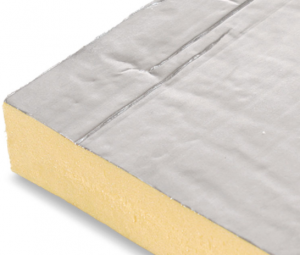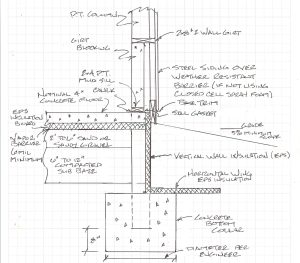High-Density Rigid Fiberglass Board
As I am prone to do, I spend hours on the internet perusing looking for new or better products and applications. Basically – how to make a better post frame building, without hurting client’s in their pockets.
Continuous insulation has become an IECC (International Energy Conservation Code) staple, with 2021’s version showing it as an optional portion of wall insulation in Climate Zones 3 and greater. Usually in board form, in post frame construction continuous insulation is best placed on the inside of wall framing, covering all structural members. Continuous insulation reduces energy loss by providing a thermal break and impeding air leakage.
Most common choice for continuous insulation is a foam board – usually (and my choice) expanded polystyrene (EPS), extruded polystyrene (XPS) or polyisocyanurate (PIR), however there are other ways to achieve this objective. One lesser-known (according to article I was reading at certainteed.com), but effective, alternative is high-density rigid foam board.
Interesting – a design solution I knew little about.
 CertainTeed offers CertaPro® Board – composed of resin-bonded glass fibers in a range of densities. It can be used to add both thermal insulation and sound absorption to interior spaces. CertaPro® board stiffness ranges from rigid to more flexible for curved and/or sharp-edged applications (granted we do not find many curved applications in post frame construction).
CertainTeed offers CertaPro® Board – composed of resin-bonded glass fibers in a range of densities. It can be used to add both thermal insulation and sound absorption to interior spaces. CertaPro® board stiffness ranges from rigid to more flexible for curved and/or sharp-edged applications (granted we do not find many curved applications in post frame construction).
CertaPro® board is available unfaced, or faced with a vapor retardant finish in either clean metallic (FSK) or attractive white (ASJ) surface. CertaPro® boards are easily cut to size and shape and to install. Additionally, unfaced and FSK faced CertaPro® boards are compliant where a fire hazard classification of 25/50 is required, can be used for exposed or non-exposed applications, resist mold and mildew and will not rot or deteriorate.
In applications where walls will dry to interior, unfaced boards should be used. For drying to exterior (higher numbered Climate zones), use products with a vapor retardant finish.
All CertaPro® boards offer a minimum R value of four (4) per inch.
Tag Archives: extruded polystyrene
Insulation Options for an Idaho Mountain Post Frame Barndominium
Loyal reader LORISTON in NAMPA writes:
“We are in the initial phase of preparing for our residential post frame home and are excited to partner with Hansen Buildings when ready. Thank you for all the amazing information and supporting your clients. Question: I am targeting a highly efficient design, with >r-40 walls and >r-60 roof. There is a lot that I do not know and humble to learn from others. My mechanical engineering background helps. I would like your advice on a wall and roof design that meets my targeted R-values incorporating (from outside to inside) metal siding, >3/4″ rain screen, rock wool >2″ external insulation, Zip insulated r sheathing for WRB and thermal break/R-value increase, laminated Timber Tech glulam columns with bookshelf / commercial girts, closed cell spray foam internal insulation around 3″ thickness, fill remaining thickness from spray foam to inside edge column with insulation (recommendation would be helpful on type of insulation), internal insulation on inside of wall for thermal break if needed or helps, with final residential area having 5/8″ sheetrock and shop area having metal inside finish. We have not solved how to create a space for utilities on the outside wall as we would prefer to run them on inside of columns or thermal break insulation. We are contemplating internal framed 2×4 walls spaced away from post frame wall to create a space for utilities. No water will be run on external walls, only power, low voltage, gas, telephone as reference. Suggestion on how to run utilities with this highly efficient wall design would be appreciated. Roof is similar to wall, just horizontal with >r-60 performance, as we are targeting a conditioned attic space. Roof exception may be a second zip sheathing layer over the insulation (under rain screen/standing seam metal) but to be determined. Climate Zone 6 region in the Idaho mountains for reference. Post frame columns and wall will be on a full foundation wall with thickness based on wall design. Performance is priority over cost, targeting an air tight and efficient living space. Your experience and practical approach are greatly appreciated. Best regards and thank you.”
Mike the Pole Barn Guru writes:
Thank you for your very kind words, they are greatly appreciated.
Rather than add an expensive and structurally unnecessary concrete foundation wall, I would recommend embedded properly pressure preservative treated wall columns (as my first choice), columns above grade set into wet set brackets on concrete piers as my second. Either of these can be insulated using R-10 EPS (Extruded Polystyrene) insulation boards. I would run them on the inside of the splash plank, with the top even with the top of the slab, extending down two feet, then outward horizontally two feet.
In Climate Zone 6, I normally would not look towards spray foam as my go to choice, however conditioning your attic and your desire for air tightness come into play, so here goes:
Walls (out-to-in): Steel siding over 2×8 bookshelf girts; 4″ of closed cell spray foam applied directly to inside of wall steel and balance of cavity with either open cell spray foam or rock wool (rock wool being my preference). No internal vapor barrier or continuous interior insulation boards as we want walls to dry to interior, without trapping moisture in the wall cavity.
Roof (out-to-in): Standing seam steel over 30# felt or synthetic ice & water shield (second preferred) over 5/8″ CDX plywood. Zip sheeting is OSB and screws just do not hold well into OSB. We can specify 2×12 roof purlins in order to get a deep cavity for insulation. Closed cell spray foam 5-3/4″ (R-40) plus R23 rock wool (5-1/2″).
This combination will require mechanical removal of humidity.
My normal recommendations would be:
Walls (out-to-in): Steel siding over a Weather Resistant Barrier, over 2×8 bookshelf girts. Fill the cavity with two layers of R15 rock wool. Add R-10 EPS well-sealed on interior. This wall will now dry to the outside.
Roof (out-to-in): Through screwed steel with an Integral Condensation Control factory applied, or standing seam steel over 30# felt or synthetic ice & water shield (second preferred) over 5/8″ CDX plywood. Roof trusses with 22″ raised heels, vent eave and ridge. Blow in R-60 on top of ceiling. This eliminates the expense of heating/cooling a dead attic space.
In either instance, I would have no fears or concerns about running non-plumbing utilities within your wall insulation cavity.
Barndominium Concrete Slab Insulation Boards – XPS or EPS?
Other than in Climate Zone’s 1 and 2 (think deep South), International Energy Conservation Code (IECC) requires perimeter and under slab continuous insulation for barndominiums.
When it comes to concrete and insulation, contractors tend to be most familiar with extruded polystyrene (XPS). Yet, expanded polystyrene (EPS) performs as well or better than XPS, and at a substantially lower cost. Three important factors to consider when comparing these two insulations for any below grade or under-slab application are compressive strength, moisture retention, and insulating capability.
Weight of concrete slabs and foundation backfill may imply highest strength insulation is most sensible. For many jobs, though, products with less compressive strength are more than sufficient and can reduce insulation costs. For example, installing a below-grade insulation rated for 100 psi, when only 40 psi is needed, will nearly double material costs.
Many designers mistakenly assume loads placed on slabs transfer through to underlying insulation and soil at a 45-degree angle instead of a more uniform distribution. This can result in greatly over-designing insulation’s strength. For example, with a forklift load on a typical 4-inch-thick slab, one calculation would indicate 32 psi is applied to insulation compared to only 2.5 psi under a more accurate calculation. As such, it is not uncommon for under slab insulation to be over-designed by a factor of 10 or more.
Using unnecessarily high-strength insulation, you end up paying for something you don’t really need. Since EPS is lower cost per inch than XPS, and is available in a range of compressive strengths (from 10 to 60 psi), using it below grade and under slabs can save on insulation costs.

A common question with rigid foam insulations is how well it resists water. A number of studies show EPS retains less moisture than XPS. A case in point is a side-by-side analysis of these two rigid foam types installed on a commercial building foundation in St. Paul, MN. When extracted and tested after 15 years in service, EPS had 4.8% moisture content by volume, compared to 18.9% for XPS (a four-fold difference). A testing lab also found XPS holds water longer than EPS. After 30 days of drying time, XPS still had elevated moisture of 15.7%, while EPS had dried to 0.7%.
For installations where insulation will be exposed to large amounts of water or frequent wetting, rigid foam insulation is available with water-resistant facers or pre-cut drainage grooves. Insulation with polymeric laminate facers keep water from entering insulation and also provide an added barrier to water wicking or diffusing through foundations and slabs.
Moisture resistance is also important for below grade and under-slab insulation, since wet products provide much lower thermal resistance. Side-by-side insulation comparison found EPS retained 94% of its specified R-value, while XPS lost nearly half of its insulating capability over 15 years.
In addition to higher moisture resistance, EPS also is not subject to thermal drift. This means its R-value stays the same over time. By comparison, XPS’s manufacturing process uses blowing agents diffusing from foam’s cellular structure over product life, thereby reducing its thermal performance. EPS manufacturers typically warrant 100% of published R-value for 20 years or more, while common XPS warranties cover just 90% of published R-value.
Whether selecting EPS or XPS insulation, to ensure performance, confirm the product was manufactured to meet requirements of ASTM C578, Standard Specification for Rigid, Cellular Polystyrene Thermal Insulation. This standard provides a key quality check on rigid insulation.
As insulation becomes increasingly common under slabs, understanding performance and cost factors of these different materials is important. EPS offers a number of advantages over more commonly installed XPS, including having highest R-value per dollar among rigid insulations, making it a cost effective choice for many jobs.






